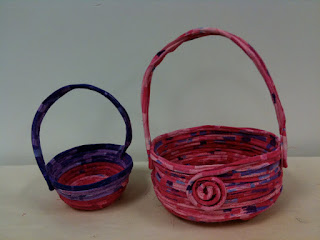
Here is the first of hopefully many "How To" articles. Pictures are of examples done at recent workshops I taught at the ARC of Anchorage or in my Girdwood Studio. See my website for contact information (www.artistsalaska.com/LeolaRutherford) or email me (leolaspottery@gmail.com) if you are interested in finding out how you can take one of Leola's pottery workshops.
Picture frames make a great Mother's Day gift.
This is a project I recently taught my students at the ARC of Anchorage. They will be giving their picture frames as Mother's Day gifts. As always, we made a few extra collaborative pieces, so if you are looking for a Mother's Day gift, go to the ARC of Anchorage. There is an ongoing pottery sale in the lobby by the front desk to help support the art program at the ARC.

My students used a variety of fabrics, stamps and found materials to roll textures into slabs of clay and then cut them out to match clear plastic picture frames we purchased at a local store.
Small cookie cutters make great openings to slide the photos in. Use an epoxy like E6000 to glue the finished pottery covering to the plastic picture frame.
These also make great mirror frames. Simply epoxy a small mirror and picture hanger to the back.
The trick in making the textures come alive is to "antique" the frame. This is a handy technique to use for any textured clay that has been bisque fired (first firing; not raw clay).

STEP 1: PAINT. Use an under glaze paint. Water it down to the consistence of skim milk. Use a thick round brush to paint on the glaze. Be sure to load your brush with paint often and "wiggle waggle" it's bristles into all the cracks. Remember, the color is only going to stay in the cracks, so don't worry about covering the high spots (you're going to wipe that off). Paint stays only in the cracks and low spots.

STEP 2: WIPE OFF. Use a clean damp (not dripping wet) sponge to wipe off the under glaze paint from the high spots. Best to do one wipe, turn sponge over, wipe again, and rinse. DO NOT keep wiping a dirty sponge over the texture, it only puts the paint back on. DO NOT use too much water, it will saturate the pottery and you will be unable to apply glaze until it dries completely.
Notice how the texture POPS out at you once you've antiqued the texture. Without this technique, texture tends to get lost.

STEP 3: ACCENT. If you wiped off too much paint in one area, simply reapply and wipe again. For interest, take full strength under glaze paint and add details and highlights to give your pottery a three dimensional look. Be sparing with your paint so you don't cover up all of the texture.

STEP 4: GLAZE. Once the pottery has dried, apply three even coats of a clear glaze with a wide soft brush. Be careful to brush in a different direction with each coat (first up/down, then back/forth, then diagonally). Also be sure to load your brush often so you don't smear the painting underneath. Avoid letting your brush go dry. Brush, dip, brush, dip, . . . Let dry completely in between each coat. You will know that the clear glaze is thick enough when you can no longer see the under glaze paint underneath.
Note: you can use this same technique with a light transparent colored over glaze. Use a dark under glaze to antique and it will help create a shadow to the textured areas beneath the glaze.
Use a clean damp sponge to wipe off the glaze that may have dripped onto the back during all this painting. If you don't, you will have to stilt the frame before firing. Glaze drips on the back will also make it difficult to epoxy the pottery to your frame of mirror.
STEP 5: FINISHING. After firing, use an epoxy like E6000 to glue your pottery to the frame. Insert a picture. It may be necessary to crop the photo or tape it in place to line up with your frame opening.
If you saved the cut out you made, you can also antique glaze and fire it. These make great pins or magnets. Simply epoxy a pin back or magnet to the back. Larger cut outs make nice wind chimes. Add a hole to them before firing.
Look for more pottery project ideas on this blog or contact Leola Rutherford (leolaspottery@gmail.com) for workshop information.


 My students used a variety of fabrics, stamps and found materials to roll textures into slabs of clay and then cut them out to match clear plastic picture frames we purchased at a local store.
My students used a variety of fabrics, stamps and found materials to roll textures into slabs of clay and then cut them out to match clear plastic picture frames we purchased at a local store.









